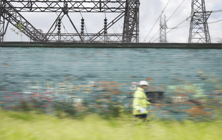
Gert Vermeiren, of infrastructure and environmental consulting major AECOM, shares his insights on delivering a just energy transition, ahead of a panel discussion devoted to this core topic at Environment Analyst’s UK Business Summit on 30 November, an in-person conference in London.
EA: Where do you see the greatest opportunities for the UK now in delivering renewable energy or alternative fuels infrastructure?
GV: There is no silver bullet in the energy transition. There will be a portfolio of energy technology solutions that collectively will enable the transformation of the energy system.
As part of that portfolio, in the UK the story over the next five years will be the consenting and building of offshore wind and solar power. The UK is already a leader in offshore wind with major wind farms including Hornsea 2 and Dogger Bank. Although the planning presumption for renewables has always been a connection to the national grid and sale of electricity, the lack of grid connection capacity is driving many developers to consider converting this electricity onsite to alternative fuels, namely hydrogen, ammonia and potentially e-methanol or sustainable aviation fuels.
The UK government, through the Department for Energy Security and Net Zero (DESNZ) has made £1bn of grant funding available, through various funding rounds, to support the delivery of early green hydrogen projects. The majority of these will connect to the national grid and source their power through a green power purchase agreement, but a number will test the case for co-location with renewable generators. These will be followed closely by industry.
The abundance of development leases for offshore wind, in Scotland for example, combined with the grid already running at capacity means that many parties are looking at hydrogen as a potential route to market. We are seeing an upsurge in hydrogen projects, from DESNZ research into the viability of hydrogen for heat in the industrial sector, through to delivering new production facilities and infrastructure such as our work on Aberdeen Hydrogen Hub and Net Zero Teesside.
Fusion development, through the STEP programme for example, and small modular reactors (SMRs) also offer great potential in delivering a safe, low carbon future. There is also growing momentum in the scale-up of charging infrastructure as fleet decarbonisation grows.
We have an opportunity to get the mix right to deliver the greatest resilience.
EA: What are the greatest challenges?
GV: The UK government’s leadership in decarbonisation is evident across several dimensions. These achievements include: the first advanced economy to legislate a net zero emissions target by 2050; the ambition of the 10 point plan for a green industrial revolution; the progress in decarbonising the UK power sector; and the hosting of COP26.
However, as illustrated in the recent UK government auction for renewable capacity, where there were no bids for offshore wind, a number of headwinds are shaping the green energy outlook. The global rise in inflation, estimated by some wind developers to be in a range of 20% to 40%, is having an adverse impact on supply chains and challenging project economics.
There is also increasing competition for international capital, as nations evolve investment frameworks to bolster their green energy ambitions. The Inflation Reduction Act in the US is allocating some $369bn of tax incentives to boost domestic spend in clean energy. Its success triggered the EU response to launch a Green Deal Industrial Plan.
From a more domestic perspective, the evolution of electricity transmission and distribution infrastructure in the UK will be critical to enabling the transition. As Eloise John, our UK&I energy lead says "there’s no transition without transmission". The lack of grid infrastructure and the complex process are undoubtedly major barriers to progressing the connection of future renewable supplies. As electrification continues to grow, we need greater flexibility in the system, as decentralised power generation feeds growing demand from the deployment of heat pumps, battery storage and electric vehicles for example.
Nick Winser, the Electricity Networks Commissioner, acknowledges the "extraordinary progress" made in developing renewable and clean energy sources in the UK to date, but adds that this "magnificent achievement will be wasted if we cannot get the power to homes and businesses." In a recent government report, he highlighted several recommendations to improve grid infrastructure. These recommendations included greater stakeholder community engagement (offering generous compensation to homeowners for the erection of high voltage power lines) to streamlining the regulatory and planning process for new transmission lines by half to seven years.
With regards to hydrogen for decarbonisation, UK government strategy is still evolving with 2026 the decision date for hydrogen policy vis-à-vis grid and heat applications. Appropriate applications of hydrogen use, better grant fund management and strong demonstration projects are needed to build confidence in hydrogen as a sustainable, economically viable and safe. More broadly, greater emphasis on stimulating hydrogen demand will be critical.
Also of note, is the well-publicised and significant green skills gap in the UK, with projects in energy transition and sustainability on the rise, impacting technical knowledge and speed of delivery.
EA: What do you see as the most effective solutions to those challenges?
GV: The National Grid’s ‘great grid upgrade’ is a much-needed modernisation programme to help deliver a decarbonised future across the UK. Navigating this substantial infrastructure delivery, rapidly and robustly, while balancing community concerns, requires a strong programmatic approach and collaboration across government, supply chains, regulators, and stakeholder communities. Wider industry adoption and integration of digital grid innovations also have the potential to unlock new avenues to increase capacity.
Every client and industry can be on rapidly different transition paths to clean forms of energy. As consultants in this space, we have a firm view on the most appropriate solution, especially in the application of hydrogen, to each of our clients needs. This often comes from our collaboration, expertise and lessons learnt in other sectors, and engaging with clients to present project ideas to solve their complex challenges – from connecting clients to funding partners, accelerating planning, and permitting and implementing effective and resilience designs.
EA: How can social equity and positive ecological impact be integrated into project design and roadmaps for the energy transition?
GV: As with any project or roadmap, it’s all about defining goals and communicating early. All energy transition projects should be there to enhance the communities and environments we live in, so involving people from the off, including the key stakeholders but also those that benefit indirectly from the energy transition will improve the diversity of insights and enrich the conversation to ensure projects are delivered equitably.
Meaningful stakeholder engagement, which informs the design of transformational infrastructure developments rather than communications after the fact, plays an important role in ensuring there are tangible, sustainable, and long-term benefits of energy transition projects for all, and potential future risks are highlighted early to avoid delays. We developed PlanEngage and our virtual consultation tool to help drive transparent and inclusive engagement.
Understanding and effectively addressing the challenges of transition on supply chains, communities and the current workforce and skills shortages are important elements of a successful and just transition.
Ecological enhancements and nature-based solutions embedded in a project’s design and delivery not only add value to the client and nature, but also the communities living alongside major schemes. However, long-term consideration of the most appropriate solutions for a healthy biodiverse environment within a project or programme is needed to increase resilience.
EA: What changes are needed to ensure an inclusive, post-transition energy economy?
GV: The energy challenges we face need to be tackled collaboratively. One of the benefits of being an integrated consultancy is our ability to look at complex problems holistically and join the dots to achieve better outcomes, rather than dealing with each in isolation. So, imagine what we could achieve if lessons learnt, best practice and innovations are shared and developed collaboratively across different industries, governments, supply chains and consultants.
Increased and improved interfaces with key stakeholders on consenting energy projects will help us transition to benefit all in society and enable vital infrastructure development, such as the great grid upgrade, to build resilience, stability, and security in our systems into the future.
Increased STEM education and retraining within the green skills space is needed to support and accelerate continuous innovation and capacity in the workforce to deliver. We’ve looked at this recently with regards increasing sustainability skills across our global operations and regularly engage with schools, universities and through our apprentice programme to encourage and educate students and potential employees in tackling the major disconnect between the demand for emerging skill sets and the level of skills in the existing talent pool. Increased digital innovations will also help close the gap on skills shortages.
—

Gert Vermeiren is the managing director of AECOM’s environment, water and energy business for Europe and India. He leads a team of 2,300 experts committed to making a positive, lasting impact on people and the planet by helping clients respond to climate change, water scarcity concerns, and the energy transition. In his 20-plus-year career, he has managed numerous large-scale environmental, building engineering and infrastructure programmes and businesses across the region.
Learn more about leading in a just energy transition to achieve a low-carbon future at Environment Analyst’s UK Business Summit on 30 November in London.
